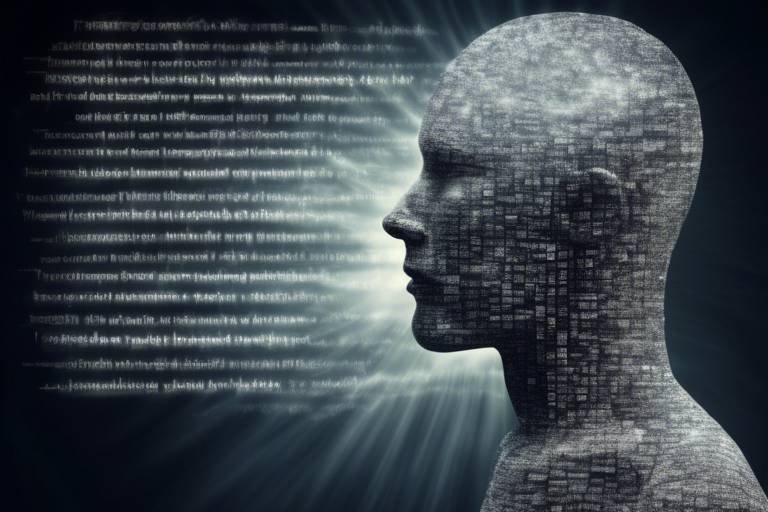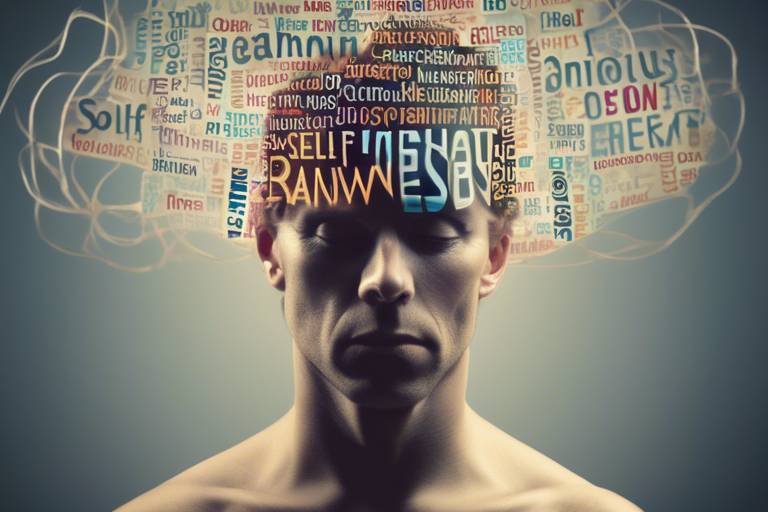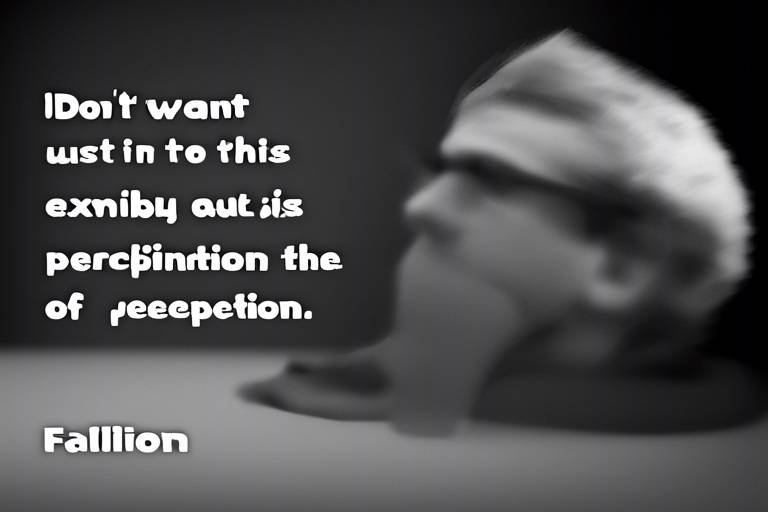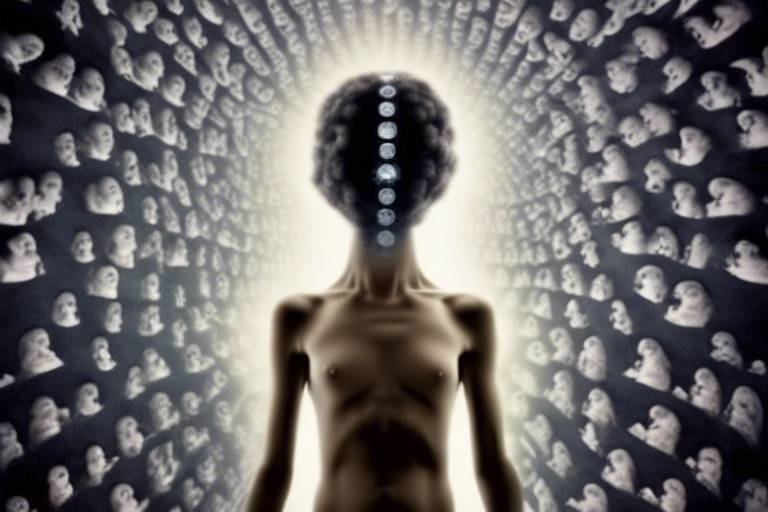Are There Unexplored Aspects of Human Consciousness?
The question of whether there are unexplored aspects of human consciousness is not just a philosophical musing; it's a profound inquiry that touches the very essence of what it means to be human. Consciousness, that elusive quality that allows us to experience the world, think, feel, and reflect, remains one of the most significant mysteries of our existence. Despite decades of research and countless theories, we still find ourselves grappling with fundamental questions: What is consciousness? How does it arise? And what lies beyond our current understanding?
To grasp the unexplored dimensions of consciousness, we must first acknowledge its complexities. Consciousness isn't merely about being awake or aware; it's a multifaceted phenomenon that encompasses a range of experiences, from the mundane to the extraordinary. Imagine it as an intricate tapestry woven from threads of perception, thought, emotion, and memory. Each thread contributes to the overall picture, yet there are countless patterns and colors yet to be discovered.
One of the most intriguing aspects of consciousness is its subjective nature. Each person's experience of consciousness is unique, shaped by their individual thoughts, feelings, and cultural backgrounds. This subjectivity raises questions about the universality of consciousness—are there shared experiences that transcend individual differences? Could there be collective dimensions of consciousness that we have yet to explore? These inquiries invite us to consider not just the individual mind but the interconnectedness of human experiences.
Moreover, the advent of modern technology has opened new doors to understanding consciousness. Neuroimaging techniques, for instance, allow us to visualize brain activity in real time, providing insights into how different mental states correlate with physical processes. Yet, as we delve deeper into the biological underpinnings of consciousness, we must remain mindful of the limitations of a purely materialistic perspective. Could there be aspects of consciousness that elude scientific measurement, like the richness of dreams or the depth of spiritual experiences?
Altered states of consciousness—whether through meditation, dreams, or psychedelics—further complicate our understanding. These states often reveal facets of consciousness that are not accessible in our everyday waking life. For example, during deep meditation, practitioners report profound insights and a sense of interconnectedness that challenges conventional notions of self. Similarly, psychedelic experiences can lead to transformative realizations about existence and reality. Are these altered states merely brain chemistry at play, or do they unlock hidden dimensions of consciousness that we have yet to comprehend?
As we ponder these questions, it's essential to recognize that the exploration of consciousness is not just an academic pursuit; it has real-world implications. Understanding consciousness can influence mental health treatments, enhance creativity, and even reshape our societal values. By embracing the unknown, we may uncover new pathways to well-being and a deeper appreciation for the human experience.
- What is consciousness? - Consciousness is the state of being aware of and able to think and perceive one's surroundings, thoughts, and emotions.
- Are there different types of consciousness? - Yes, consciousness can vary in states such as waking, dreaming, and altered states induced by meditation or substances.
- How do scientists study consciousness? - Scientists use various methods, including neuroimaging, cognitive psychology, and phenomenological approaches to explore consciousness.
- Can consciousness exist outside the brain? - This is a debated topic; some theories suggest that consciousness may have dimensions beyond physical processes, while others argue it is entirely brain-based.

The Nature of Consciousness
Understanding what consciousness truly is can feel like trying to catch smoke with your bare hands. It's an elusive concept that has puzzled philosophers, scientists, and curious minds for centuries. At its core, consciousness refers to the state of being aware of and able to think about one's own existence, thoughts, and surroundings. This awareness encompasses a vast array of experiences, emotions, and perceptions that shape our reality.
To grasp the full complexity of consciousness, we must explore its various definitions and characteristics. Some define it as a continuous stream of thoughts and feelings, while others view it as a collection of discrete moments of awareness. This leads us to ponder: Is consciousness a singular phenomenon, or is it a tapestry woven from multiple threads of experience? One might argue that it resembles a multifaceted gem, reflecting different aspects of our inner world depending on how we look at it.
Philosophical debates surrounding consciousness add another layer of intrigue. Questions arise such as: What is the relationship between the mind and the body? Can consciousness exist independently of physical form? These inquiries have given rise to various theories, each offering unique perspectives on the nature of consciousness. For instance, dualism posits a distinct separation between mind and body, while materialism suggests that consciousness is merely a byproduct of physical processes in the brain. The ongoing discourse between these schools of thought demonstrates that our understanding of consciousness is still very much a work in progress.
Moreover, the characteristics of consciousness can be categorized into several dimensions, including:
- Awareness: The ability to perceive and respond to internal and external stimuli.
- Intentionality: The capacity to direct thoughts and attention towards specific objects or ideas.
- Unity: The experience of a cohesive self, where thoughts and perceptions are integrated into a single narrative.
- Continuity: The flow of conscious experience over time, providing a sense of personal identity.
As we delve deeper into the nature of consciousness, we uncover a realm filled with mysteries and potential discoveries. The question remains: are there unexplored aspects of consciousness that could reshape our understanding of the mind? With advancements in technology and research methodologies, we stand on the brink of uncovering new dimensions of consciousness that have previously eluded us. The journey into the depths of our consciousness is not just an academic pursuit; it is a profound exploration of what it means to be human.
Q: What is consciousness?
A: Consciousness is the state of being aware of and able to think about one's own existence, thoughts, and surroundings.
Q: Are there different types of consciousness?
A: Yes, consciousness can be categorized into various dimensions, including awareness, intentionality, unity, and continuity.
Q: How do philosophers view consciousness?
A: Philosophers have developed various theories about consciousness, including dualism, which separates mind and body, and materialism, which views consciousness as a byproduct of physical processes.
Q: Can consciousness exist independently of the body?
A: This question is a topic of ongoing debate among philosophers and scientists, with differing opinions based on various theoretical perspectives.

Historical Perspectives
The exploration of consciousness isn't just a modern endeavor; it has deep roots that stretch back through the annals of history. Think about it—human beings have been pondering the nature of their own awareness for centuries. From ancient philosophers to contemporary scientists, the quest to understand consciousness has evolved, reflecting the prevailing cultural and scientific paradigms of their times. As we delve into historical perspectives, we uncover a tapestry of ideas that have shaped our current understanding.
In ancient times, thinkers like Plato and Aristotle laid the groundwork for philosophical discussions about the mind and soul. They pondered questions like, "What is the essence of being?" and "How does the mind relate to the body?" These inquiries were foundational, igniting a spark that would lead to centuries of debate. Fast forward to the Enlightenment, where René Descartes famously declared, "Cogito, ergo sum" (I think, therefore I am). His dualistic view posited a distinct separation between mind and body, suggesting that consciousness was something separate from the physical realm. This notion opened the floodgates for further exploration and inquiry.
As we moved into the 19th and 20th centuries, the scientific approach to consciousness began to take shape. Thinkers like Sigmund Freud introduced the idea of the unconscious mind, suggesting that much of our behavior is influenced by thoughts and feelings that lie beneath our conscious awareness. This was revolutionary! Freud's theories, although controversial, paved the way for a deeper understanding of the complexities of human thought and emotion.
Simultaneously, the advent of psychology as a discipline brought forth figures like William James, who emphasized the fluid and dynamic nature of consciousness. James proposed that consciousness is not a static entity but rather a stream of thoughts, feelings, and perceptions that flow continuously. His work laid the groundwork for modern psychological theories and opened the door for empirical studies of consciousness.
In the latter half of the 20th century, the field of cognitive science emerged, blending psychology, neuroscience, and philosophy to explore consciousness from multiple angles. Researchers began utilizing advanced technology to study brain activity, revealing fascinating insights into how our minds operate. Neuroimaging techniques, such as fMRI and EEG, allowed scientists to observe the brain in action, providing a tangible framework for understanding the neural correlates of consciousness.
Today, the historical perspectives on consciousness serve as a backdrop against which contemporary debates unfold. With every new discovery, we find ourselves revisiting these age-old questions. Are we merely biological machines, or is there something more to our conscious experience? As we stand on the shoulders of giants, we must acknowledge the rich history that has shaped our understanding of the mind. The evolution of thought surrounding consciousness is a testament to humanity's enduring curiosity and desire to unravel the mysteries of our own existence.

Philosophical Theories
The exploration of consciousness is not just a scientific endeavor; it is deeply rooted in philosophical inquiry. Throughout history, philosophers have grappled with the question of what consciousness is and how it relates to our existence. Several key philosophical theories have emerged, each offering unique insights into this complex topic. These theories can be broadly categorized into three main perspectives: dualism, materialism, and panpsychism.
Dualism, famously articulated by René Descartes, posits that the mind and body are fundamentally distinct entities. This theory suggests that while our physical bodies are made of matter, our consciousness exists in a non-physical realm. Descartes famously declared, “I think, therefore I am,” highlighting the idea that the act of thinking is proof of one's existence as a conscious being. This separation leads to profound implications for understanding consciousness, as it raises questions about how these two realms interact. For instance, how can something non-physical influence a physical body? This conundrum has fueled debates among philosophers and scientists alike, as they seek to understand the nature of this interaction.
On the other hand, materialism presents a contrasting viewpoint. This perspective argues that consciousness is a product of physical processes within the brain. According to materialists, everything about our conscious experience can be explained through neurobiology and the functioning of the brain's complex networks. This view challenges traditional notions of consciousness, suggesting that our thoughts, feelings, and perceptions are merely byproducts of biochemical reactions. As science advances, particularly in fields like neuroscience, materialism gains traction, prompting researchers to explore how brain activity correlates with conscious experience. However, this raises a critical question: if consciousness is simply a byproduct of physical processes, what happens to our sense of self and subjective experience?
Then, we have panpsychism, a less conventional but increasingly discussed theory. This perspective posits that consciousness is a fundamental aspect of all matter, suggesting that everything, from a grain of sand to a human being, possesses some form of consciousness. Panpsychism challenges the traditional boundaries of consciousness, proposing that it is not exclusive to complex organisms but is a universal trait. This theory opens up intriguing discussions about the nature of consciousness and its potential manifestations in different forms. Could a rock possess a rudimentary form of awareness? While this idea may seem far-fetched, it encourages us to rethink our assumptions about consciousness and its relationship to the physical world.
These philosophical theories provide a rich tapestry of ideas that help us navigate the enigmatic landscape of consciousness. Each theory carries its own implications, shaping our understanding of the mind-body relationship and influencing contemporary discussions in both philosophy and science. As we continue to explore the depths of human consciousness, these philosophical frameworks serve as crucial lenses through which we can interpret our experiences and the nature of existence itself.
- What is dualism? Dualism is the philosophical theory that posits a distinction between the mind and body, suggesting they are fundamentally different substances.
- How does materialism explain consciousness? Materialism argues that consciousness arises solely from physical processes in the brain, viewing thoughts and feelings as products of neurobiological activity.
- What is panpsychism? Panpsychism is the idea that consciousness is a fundamental feature of all matter, implying that even simple entities possess some form of awareness.
- Why is the study of consciousness important? Understanding consciousness can provide insights into human behavior, mental health, and the nature of reality, influencing various fields from psychology to philosophy.

Descartes and Dualism
René Descartes, a pivotal figure in the history of philosophy, is best known for his formulation of dualism, a theory that posits a distinct separation between the mind and the body. This profound idea emerged during the 17th century, a time of significant intellectual upheaval. Descartes famously declared, "Cogito, ergo sum" or "I think, therefore I am," which encapsulates his belief that the act of thinking is proof of one's existence and consciousness. But what does this mean for our understanding of consciousness?
At its core, dualism suggests that the mind and body are fundamentally different substances. The body is physical and can be studied through the lens of science, while the mind is non-physical and encompasses thoughts, emotions, and consciousness itself. This separation raises intriguing questions: How do these two realms interact? Can the mind influence the body, and vice versa? Descartes argued that this interaction occurs in the pineal gland, a small gland in the brain, which he believed was the "seat of the soul." This notion, while groundbreaking at the time, has led to extensive debate and criticism.
Many contemporary philosophers and scientists challenge Descartes' dualism, advocating for alternative perspectives that merge the mind and body into a single entity. For instance, materialism posits that everything about the mind can be explained through physical processes. This raises the question of whether consciousness is merely a byproduct of neural activity. Yet, Descartes' dualism remains a crucial point of reference in discussions about consciousness, as it highlights the complexities of our understanding of the mind.
To further illustrate the implications of Descartes' dualism, consider the following table that summarizes key aspects:
| Aspect | Descartes' Dualism | Materialism |
|---|---|---|
| Nature of Mind | Non-physical, separate from the body | Physical, arising from brain activity |
| Interaction | Pineal gland as the interaction point | Mind and body are one; no interaction needed |
| Implications | Consciousness is distinct and may survive bodily death | Consciousness ceases to exist when brain activity stops |
Despite the criticisms, Descartes' dualism has paved the way for numerous discussions and explorations into the nature of consciousness. It invites us to ponder our existence and the intricate relationship between our thoughts and our physical selves. As we continue to explore the depths of consciousness, the questions raised by dualism remain relevant, urging us to seek a deeper understanding of what it truly means to be conscious.
- What is dualism? Dualism is the philosophical position that the mind and body are two distinct entities that interact with each other.
- Who is René Descartes? René Descartes was a 17th-century philosopher who is known for his contributions to modern philosophy and his theory of dualism.
- How does dualism relate to consciousness? Dualism suggests that consciousness is a non-physical entity that exists separately from the physical body.
- What are the criticisms of dualism? Critics argue that dualism fails to explain how the mind and body interact and that all mental processes can be attributed to physical brain activity.

Contemporary Materialism
In the realm of consciousness studies, stands as a formidable perspective, asserting that our conscious experiences are fundamentally rooted in physical processes. This view diverges sharply from more traditional notions that separate mind from body, suggesting instead that everything we perceive, feel, and think can be traced back to neural activities and biochemical reactions. Imagine consciousness as a complex symphony, where each note corresponds to a specific brain function, and the entire orchestra is guided by the conductor of our physical body. This analogy captures the essence of materialism: the belief that the mind is not an ethereal entity but rather a product of tangible, biological components.
One of the most compelling arguments for contemporary materialism lies in the advancements of neuroscience. With technologies like functional magnetic resonance imaging (fMRI) and electroencephalography (EEG), scientists have made significant strides in mapping brain activity to specific thoughts and emotions. For example, studies have shown that when we experience joy, certain areas of the brain, such as the ventral striatum, light up, providing a direct correlation between a physical state and a conscious experience. This has led to a growing consensus that understanding consciousness requires a deep dive into the biological mechanisms that underpin it.
However, the implications of this perspective are profound and raise numerous questions. If consciousness is merely a byproduct of brain activity, what does that mean for our sense of self? Are we simply the sum of our neural connections? This line of inquiry challenges the very fabric of our understanding of identity and agency. Many proponents of contemporary materialism argue that embracing this view can lead to practical benefits, such as improved mental health treatments and a more grounded approach to psychological issues. Yet, critics caution that reducing consciousness to mere biology risks overlooking the richness of human experience.
Furthermore, contemporary materialism has sparked vibrant discussions within the scientific community. Researchers are now exploring the boundaries of consciousness, asking whether phenomena like emergent properties might play a role. For instance, could consciousness emerge from complex interactions within the brain, similar to how a flock of birds behaves as a unit, despite each bird acting independently? This notion opens the door to the possibility that while materialism provides a framework, it may not fully encapsulate the entirety of human consciousness.
In conclusion, contemporary materialism invites us to reconsider our understanding of consciousness as a purely physical phenomenon. It challenges us to explore the implications of this perspective while also acknowledging the rich tapestry of human experience that may not be entirely reducible to biological processes. As we continue to investigate the mysteries of the mind, the dialogue between materialism and other philosophical perspectives will undoubtedly enrich our quest for knowledge.
- What is contemporary materialism? Contemporary materialism is the view that consciousness arises solely from physical processes in the brain, suggesting that our thoughts and feelings are rooted in biological functions.
- How does neuroscience support contemporary materialism? Neuroscience uses advanced imaging techniques to link specific brain activities to conscious experiences, providing evidence that consciousness is tied to physical brain states.
- Are there limitations to contemporary materialism? Yes, critics argue that this perspective may overlook the complexity of human experience and the subjective qualities of consciousness that may not be fully explained by biology alone.
- What are emergent properties in relation to consciousness? Emergent properties refer to phenomena that arise from complex systems, suggesting that consciousness could emerge from intricate interactions within the brain rather than being solely reducible to its physical components.

Scientific Approaches
When it comes to understanding the complexities of human consciousness, science has taken a front-row seat in the exploration of this intricate subject. Researchers and scientists have employed a variety of methods to peel back the layers of consciousness, striving to uncover the biological and psychological foundations of our conscious experience. One of the most significant advancements in this field is the use of neuroimaging techniques, which allow us to visualize brain activity in real-time. Techniques such as fMRI (functional Magnetic Resonance Imaging) and PET (Positron Emission Tomography) provide invaluable insights into how different areas of the brain are activated during various conscious states, including perception, decision-making, and emotional responses.
In addition to neuroimaging, cognitive psychology plays a crucial role in understanding consciousness. This branch of psychology focuses on the mental processes involved in perception, memory, and problem-solving. By conducting experiments that analyze how we think, remember, and make decisions, cognitive psychologists can shed light on the mechanisms that underlie conscious thought. For instance, researchers often use tasks that require participants to focus on specific stimuli while ignoring others, revealing how attention shapes our conscious experience. The findings from these studies not only enhance our understanding of consciousness but also have practical applications in areas like education and mental health.
Moreover, consciousness is not a one-size-fits-all phenomenon; it is influenced by various factors, including neurotransmitters and hormones. For instance, the role of serotonin and dopamine in mood regulation and perception highlights the biochemical underpinnings of our conscious experience. Understanding how these chemicals interact with our brain can lead to breakthroughs in treating mental health disorders, as many of these conditions stem from disruptions in consciousness.
| Research Method | Description | Applications |
|---|---|---|
| fMRI | Measures brain activity by detecting changes in blood flow. | Understanding brain functions during different tasks. |
| PET | Uses radioactive tracers to visualize metabolic processes in the brain. | Studying brain disorders and cognitive functions. |
| Cognitive Experiments | Tests designed to analyze mental processes. | Improving educational techniques and mental health interventions. |
As we venture further into the realm of consciousness, we find ourselves at the intersection of science and philosophy. The scientific approaches to studying consciousness not only challenge our preconceived notions but also open up new avenues for inquiry. For example, the integration of artificial intelligence and machine learning in analyzing vast amounts of data related to brain activity can lead to unprecedented insights. Imagine a future where we can predict conscious states or even enhance cognitive functions through targeted interventions. The possibilities are both exciting and daunting, as they push us to reconsider what it means to be conscious.
In summary, the scientific approaches to understanding consciousness are multifaceted and ever-evolving. By harnessing the power of technology and psychology, researchers are uncovering the mysteries of the mind, paving the way for new discoveries that could redefine our understanding of what it means to be human. As we continue to explore these scientific pathways, we may very well uncover aspects of consciousness that remain shrouded in mystery, waiting for us to discover their significance.
- What is consciousness? Consciousness refers to the state of being aware of and able to think and perceive one's surroundings, thoughts, and feelings.
- How do scientists study consciousness? Scientists use various methods, including neuroimaging techniques like fMRI and PET scans, as well as cognitive psychology experiments.
- What role do neurotransmitters play in consciousness? Neurotransmitters like serotonin and dopamine influence mood and perception, impacting our conscious experience.
- Can consciousness be altered? Yes, altered states of consciousness can be induced through various means such as meditation, sleep, and the use of psychedelics.

Altered States of Consciousness
Altered states of consciousness (ASC) are fascinating phenomena that have intrigued humanity for centuries. These states can occur in various forms, from the vivid imagery of dreams to the profound experiences induced by meditation and psychedelics. Each of these states offers a unique glimpse into the complexities of the human mind, challenging our conventional understanding of consciousness. But what exactly do these altered states reveal about our mental landscape? Are they merely byproducts of our brain's activity, or do they hold deeper significance that could reshape our perceptions of reality?
One of the most intriguing aspects of altered states is their ability to expand our awareness beyond the confines of ordinary consciousness. For instance, during dreams, individuals often experience a reality that feels as tangible as waking life, filled with emotions, narratives, and even insights into their waking experiences. Researchers have long studied dreams to uncover their meanings, suggesting that they may serve as a bridge to our unconscious mind, revealing hidden thoughts and feelings. The act of dreaming can be seen as a metaphorical journey into the self, where the boundaries of time and space blur, allowing for a rich tapestry of experiences.
In addition to dreaming, meditation is another powerful method for accessing altered states of consciousness. Through focused attention and mindfulness, practitioners can achieve states of deep relaxation and heightened awareness. This practice not only enhances self-awareness but also promotes mental clarity and emotional stability. Many individuals report profound experiences during meditation, describing feelings of interconnectedness and unity with the universe. These experiences challenge the notion of a separate self, suggesting that consciousness might be more fluid and expansive than we typically perceive.
Furthermore, the resurgence of interest in psychedelic research has opened new avenues for understanding altered states. Substances like psilocybin, LSD, and ayahuasca have been shown to induce profound alterations in perception, cognition, and emotional experience. Recent studies indicate that these substances can facilitate therapeutic breakthroughs for individuals suffering from conditions like depression and anxiety. The mechanisms behind these experiences are still being explored, but many researchers believe that psychedelics may temporarily dissolve the ego, allowing individuals to access deeper layers of consciousness and foster a sense of connectedness.
To illustrate the various altered states and their potential impacts, consider the following table summarizing key characteristics:
| Type of Altered State | Description | Potential Benefits |
|---|---|---|
| Dreaming | A state of consciousness experienced during sleep, characterized by vivid imagery and narratives. | Insights into subconscious thoughts and emotions; creative problem solving. |
| Meditation | A practice that involves focusing the mind to achieve a heightened state of awareness and relaxation. | Increased self-awareness; emotional regulation; stress reduction. |
| Psychedelics | Substances that alter perception and cognition, often leading to profound spiritual experiences. | Therapeutic effects for mental health conditions; enhanced creativity; feelings of unity. |
In conclusion, altered states of consciousness serve as a reminder of the vast potential of the human mind. Each state, whether experienced through dreams, meditation, or psychedelics, offers a unique perspective on consciousness and the nature of reality. As we continue to explore these dimensions, we may uncover not only the mysteries of our own psyche but also insights that could transform our understanding of what it means to be conscious.
- What are altered states of consciousness? Altered states of consciousness are variations in mental state that differ from normal waking consciousness, often characterized by changes in perception, emotion, and cognition.
- How can altered states be induced? They can be induced through various methods such as dreaming, meditation, and the use of psychedelics.
- What benefits can come from exploring altered states? Exploring these states can lead to greater self-awareness, emotional healing, and insights into the nature of consciousness.

Dream Analysis
Dreams have long fascinated humanity, acting as a portal into the unconscious mind. They are like a theater where our deepest fears, desires, and thoughts play out in vivid scenarios, often defying the laws of reality. Have you ever woken up from a dream and wondered what it all meant? Or perhaps you’ve experienced a dream so surreal that it lingered in your mind throughout the day? This is the essence of dream analysis—a practice that seeks to decode the messages hidden within our nightly narratives.
Throughout history, various cultures and psychological theories have attempted to interpret dreams, viewing them as significant reflections of our inner selves. For instance, Sigmund Freud, the father of psychoanalysis, believed that dreams are a window into our repressed desires and unresolved conflicts. He famously stated, “Dreams are the royal road to the unconscious.” This perspective encourages us to consider our dreams not just as random images but as meaningful experiences that can reveal our innermost thoughts.
In contemporary psychology, dream analysis has evolved, incorporating both scientific research and therapeutic practices. Researchers utilize tools like neuroimaging to study brain activity during sleep, providing insights into how and why we dream. This scientific approach has led to fascinating discoveries about the REM (Rapid Eye Movement) stage of sleep, where most vivid dreaming occurs. During this phase, the brain is highly active, and it is believed that dreams play a crucial role in memory consolidation and emotional processing.
Understanding the content of our dreams can also help us navigate our waking lives. For example, recurring themes or symbols in dreams may highlight unresolved issues or emotional states that need our attention. Here are a few common dream themes and their potential interpretations:
- Falling: Often associated with feelings of insecurity or loss of control.
- Flying: This can symbolize a desire for freedom or escape from limitations.
- Being chased: Typically represents avoidance of a situation or fear of confrontation.
- Teeth falling out: This may reflect anxieties about appearance or fear of aging.
Moreover, engaging in dream journaling can enhance our understanding of these nighttime adventures. By recording our dreams upon waking, we can begin to notice patterns and recurring symbols, which can lead to deeper insights over time. This practice not only helps in remembering dreams but also fosters a greater connection with our subconscious, making us more aware of our emotional landscape.
In conclusion, dream analysis opens up a fascinating dialogue between our conscious and unconscious selves. It allows us to explore the rich tapestry of our inner world, offering clues to our thoughts, emotions, and even our future paths. Whether viewed through the lens of psychology, culture, or personal introspection, dreams remain a powerful tool for self-discovery and understanding.
Q1: What are the main theories behind dream analysis?
A1: The main theories include Freudian psychoanalysis, which sees dreams as reflections of repressed desires, and cognitive theories that view dreams as a way to process experiences and emotions.
Q2: How can I remember my dreams better?
A2: Keeping a dream journal by your bedside and writing down your dreams immediately upon waking can significantly improve your dream recall.
Q3: Are dreams the same for everyone?
A3: No, dreams are highly personal and can vary greatly from person to person based on individual experiences, emotions, and cultural backgrounds.
Q4: Can dreams predict the future?
A4: While some people believe in prophetic dreams, most psychologists view dreams as reflections of our current thoughts and feelings rather than actual predictions of future events.
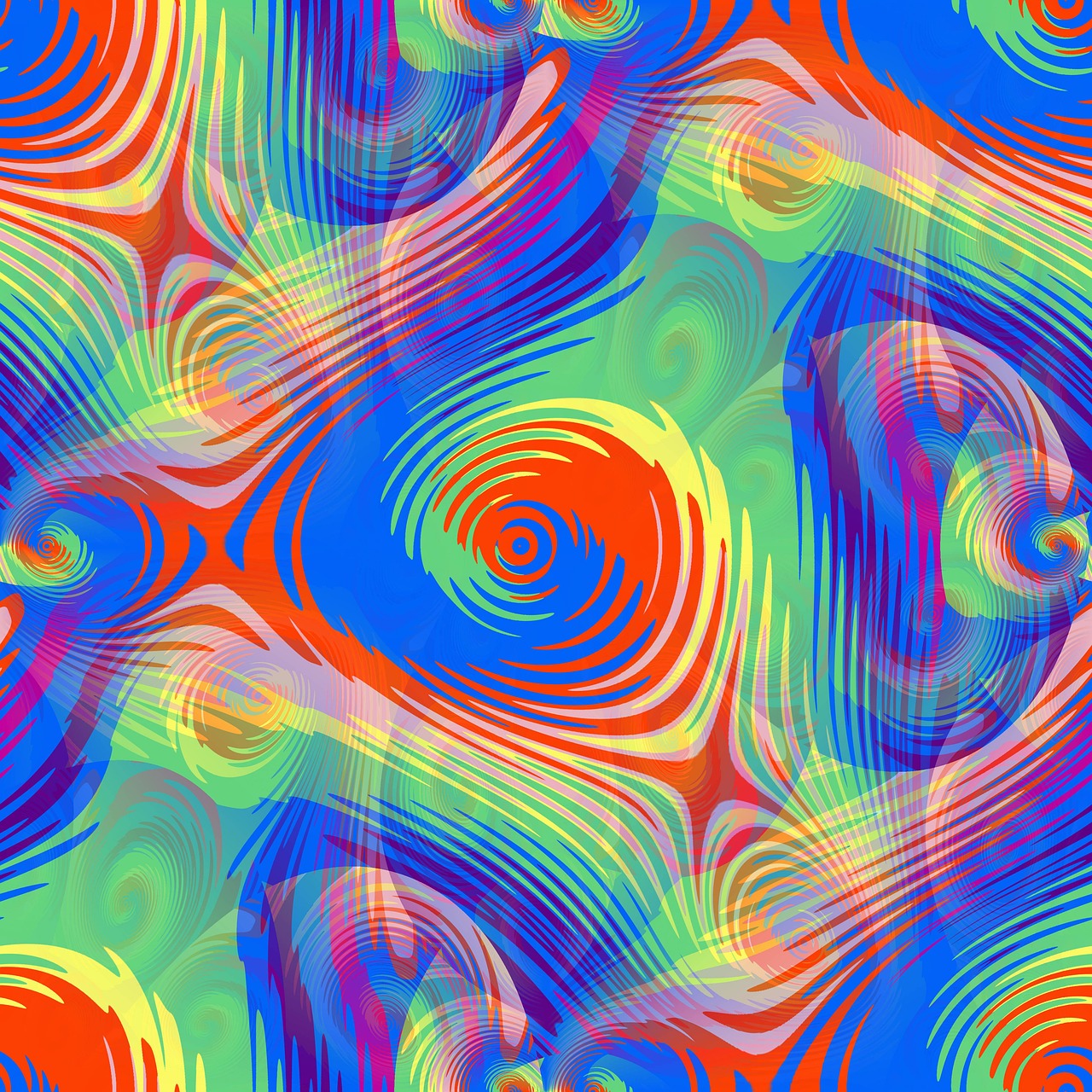
Psychedelic Research
Psychedelic research has emerged as a groundbreaking field that is reshaping our understanding of consciousness and mental health. With substances like psilocybin, LSD, and ayahuasca gaining attention, researchers are delving into their potential therapeutic benefits and how they can alter human perception and experience. Imagine diving deep into the ocean of your own mind, uncovering treasures of insight and emotional healing that were previously hidden beneath the surface. This is the essence of what psychedelic research aims to explore.
Recent studies have indicated that psychedelics can significantly impact mental health conditions such as depression, anxiety, and PTSD. For instance, a study conducted at Johns Hopkins University found that participants who received psilocybin treatment reported substantial decreases in anxiety and depression, with effects lasting for months after just a few sessions. This suggests that psychedelics might not only alter our state of consciousness but could also be a key to unlocking new pathways for emotional resilience and mental clarity.
Moreover, the mechanisms behind these substances are equally fascinating. When psychedelics enter the brain, they interact with serotonin receptors, particularly the 5-HT2A receptor, which plays a crucial role in mood regulation and perception. This interaction can lead to a profound sense of interconnectedness, often described as a feeling of oneness with the universe. Many users report experiencing vivid visual and auditory hallucinations, deep emotional insights, and a reevaluation of their life’s purpose. These experiences can be likened to the feeling of standing on a mountaintop, where everything seems clearer, and the vastness of existence unfolds before you.
However, it's essential to approach this field with caution. While the therapeutic potential of psychedelics is promising, they are not without risks. Adverse reactions can occur, and the setting in which these substances are taken plays a critical role in the overall experience. A safe and supportive environment can lead to positive outcomes, whereas a chaotic or uncomfortable setting can result in negative experiences, often referred to as "bad trips." Therefore, researchers emphasize the importance of guided sessions under professional supervision to maximize benefits while minimizing risks.
As we continue to explore the depths of consciousness through psychedelic research, it opens up a Pandora's box of questions regarding the nature of reality and the human experience. What if these substances are not just tools for healing, but also gateways to understanding the very fabric of our existence? The implications are vast and could potentially shift our cultural narratives surrounding mental health and spirituality. Just as explorers once ventured into uncharted territories, today’s scientists are navigating the intricate landscapes of the human mind, seeking to uncover the mysteries that lie within.
In conclusion, psychedelic research is not merely about the substances themselves but about what they reveal about the human condition. As we stand on the brink of a new understanding, it is crucial to approach this field with an open mind and a sense of responsibility. The psychedelic experience may just be one of the many unexplored aspects of consciousness waiting to be understood, offering a glimpse into the profound complexity of our minds.
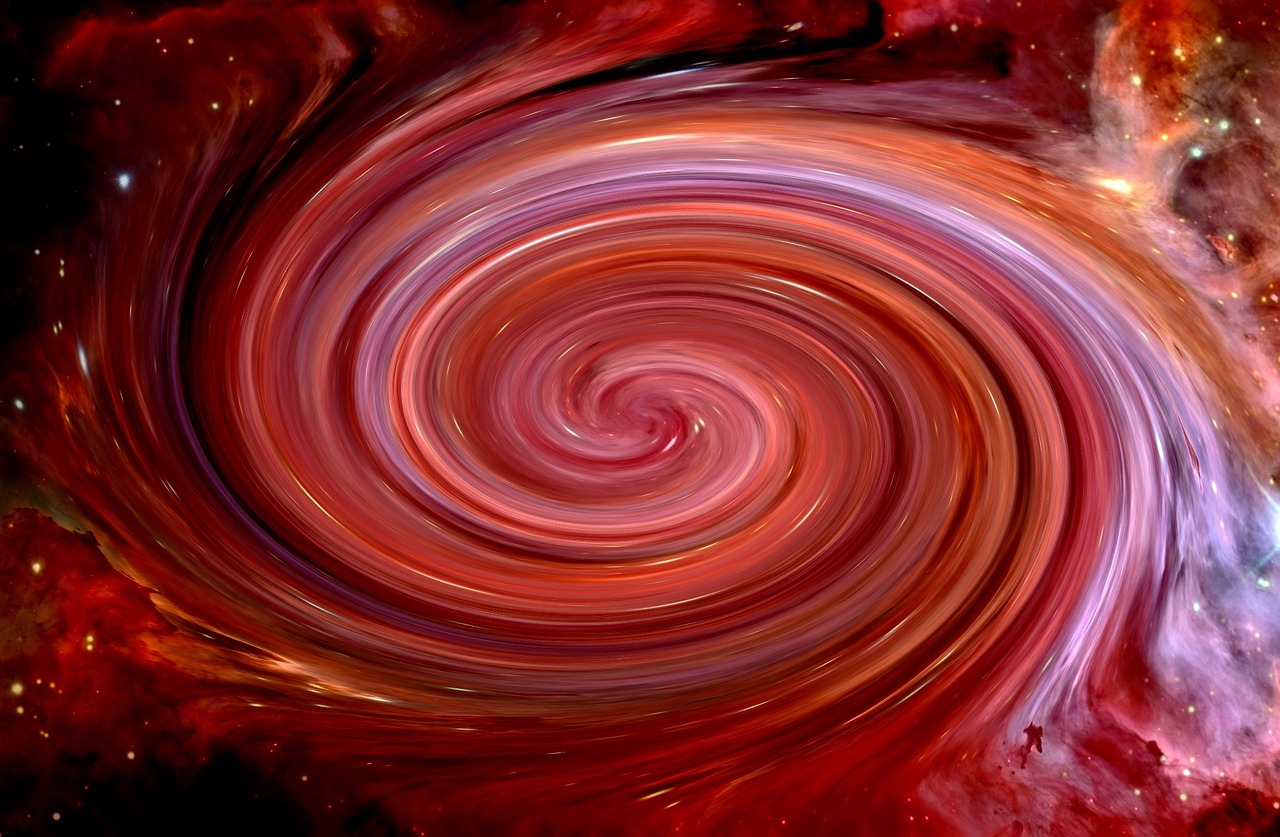
The Role of Culture
Culture plays an integral role in shaping our understanding and experience of consciousness. It acts as a lens through which we interpret our mental states, beliefs, and the very essence of what it means to be aware. From the stories we tell to the rituals we practice, culture influences our perceptions of self and reality. Have you ever noticed how different cultures have unique ways of expressing thoughts and emotions? This diversity is not just fascinating; it reveals the profound impact of cultural frameworks on our consciousness.
In many indigenous cultures, for instance, consciousness is often viewed as a collective experience. The idea of interconnectedness permeates their understanding of the mind, suggesting that individual consciousness is intertwined with the community and the environment. This contrasts sharply with Western perspectives, which tend to emphasize individualism and personal identity. In these cultures, dreams, visions, and altered states are not merely personal experiences but are seen as vital connections to the spiritual world and communal knowledge.
Moreover, contemporary cultural narratives, especially those propagated through media, significantly shape societal perceptions of consciousness. For example, the rise of mindfulness and wellness trends in popular culture has led many to explore meditation and other practices aimed at enhancing consciousness. These practices are often marketed as pathways to self-discovery and mental clarity, reflecting a cultural shift towards valuing mental health and introspection. However, the commercialization of these practices can sometimes strip them of their deeper cultural significance, leading to a superficial understanding of their true potential.
To further illustrate this point, consider the following table that outlines the contrasting views of consciousness in different cultural contexts:
| Cultural Context | View of Consciousness | Key Characteristics |
|---|---|---|
| Indigenous Cultures | Collective and Interconnected | Emphasizes community, spirituality, and nature |
| Western Cultures | Individualistic | Focus on personal identity and self-awareness |
| Eastern Philosophies | Transcendent | Seeks unity with the universe and enlightenment |
As we navigate through these diverse cultural landscapes, it's essential to recognize how they influence our understanding of consciousness. For instance, in many Eastern philosophies, the concept of non-duality suggests that the distinction between self and other is an illusion, urging individuals to seek a deeper connection with the universe. This perspective can lead to profound shifts in consciousness, fostering a sense of peace and unity that contrasts with the often fragmented sense of self promoted in Western societies.
Ultimately, the role of culture in shaping our consciousness cannot be overstated. It not only informs our beliefs and practices but also plays a crucial part in the ongoing exploration of what it means to be conscious. As we continue to study consciousness, acknowledging the cultural dimensions will be vital in uncovering the rich tapestry of human experience. So, the next time you ponder the nature of your thoughts or emotions, consider the cultural backdrop against which they unfold. Isn't it fascinating how our backgrounds influence our very understanding of reality?
- How does culture influence individual consciousness?
Cultural frameworks shape our perceptions, beliefs, and practices regarding mental states, leading to diverse understandings of consciousness. - What are some examples of consciousness in indigenous cultures?
Indigenous cultures often view consciousness as interconnected, emphasizing community and spiritual dimensions in their understanding of mental states. - How has modern media affected perceptions of consciousness?
Contemporary media promotes trends like mindfulness and wellness, shaping public discourse and personal experiences related to consciousness.

Indigenous Perspectives
When we think about consciousness, it’s easy to get caught up in the scientific jargon and philosophical debates that dominate Western thought. However, offer a refreshing and profound understanding of consciousness that challenges conventional views. For many Indigenous cultures, consciousness is not merely an individual experience but a collective and interconnected phenomenon. This perspective emphasizes a deep relationship between humans, nature, and the cosmos, highlighting the idea that consciousness extends beyond the human mind.
In many Indigenous belief systems, consciousness is viewed as a web of interconnectedness. This means that every being—be it a tree, an animal, or a human—shares a consciousness that is intricately linked. Such beliefs foster a sense of responsibility towards the environment and all living things. For example, when Indigenous peoples engage in rituals or ceremonies, they often invoke the spirits of nature, recognizing that their consciousness is part of a larger ecosystem. This contrasts sharply with the often individualistic approach seen in Western paradigms.
Moreover, Indigenous cultures often emphasize the importance of dreams and visions as pathways to understanding consciousness. Dreams are not just a byproduct of sleep; they are seen as a vital means of communication with the spirit world. Through dreams, individuals can gain insights into their lives and the greater universe. This belief is rooted in the idea that consciousness can transcend the physical realm, allowing for a dialogue between the living and the spiritual. The concept of dream-sharing within some communities illustrates how collective consciousness can manifest in shared experiences, further reinforcing the interconnectedness of all beings.
Another fascinating aspect of Indigenous perspectives is the use of altered states of consciousness achieved through traditional practices such as meditation, drumming, and the use of sacred plants. These methods are not merely for personal enlightenment; they are communal experiences that deepen the understanding of consciousness as a shared journey. In this context, rituals become a means to access higher states of awareness, fostering a deeper connection to the earth and the cosmos.
In summary, Indigenous perspectives on consciousness challenge us to rethink our understanding of the mind. They invite us to consider the interconnectedness of all life and the roles that spirituality, community, and nature play in shaping our consciousness. As we explore these rich traditions, we may find new insights that can significantly enhance our understanding of what it means to be conscious.
- What is the primary difference between Indigenous and Western views on consciousness?
Indigenous views often see consciousness as interconnected with nature and the cosmos, while Western views tend to focus on individual experiences and scientific explanations. - How do Indigenous cultures use dreams in their understanding of consciousness?
Dreams are viewed as vital communications with the spirit world, providing insights and fostering a sense of shared experience among community members. - What role do altered states of consciousness play in Indigenous practices?
Altered states are achieved through rituals and sacred practices, allowing individuals and communities to access higher awareness and deepen their connection to the universe.

Modern Cultural Narratives
In today's fast-paced world, our understanding of consciousness is heavily influenced by the narratives we encounter through various forms of media. From films and television shows to social media platforms, these narratives shape our perceptions of what it means to be conscious, aware, and alive. They create a lens through which we interpret our experiences and the experiences of others, often blurring the lines between reality and fiction. For instance, the portrayal of altered states of consciousness in popular culture often romanticizes or sensationalizes experiences like dreaming, meditation, and psychedelic journeys, leading us to question the authenticity of our own experiences.
Moreover, modern narratives frequently explore themes of identity and self-awareness, prompting us to reflect on how our consciousness is intertwined with our cultural and social identities. The rise of digital media has amplified these narratives, allowing for a more diverse range of voices and experiences to be shared. This democratization of storytelling can foster a greater understanding of consciousness as a shared human experience, yet it can also lead to confusion and misinformation. The challenge lies in discerning which narratives resonate with our personal truths and which are merely reflections of societal expectations.
To illustrate the impact of modern cultural narratives on consciousness, consider the following aspects:
- Influence of Social Media: Platforms like Instagram and TikTok shape how we present ourselves and perceive others, often leading to a curated version of reality that can distort our understanding of genuine consciousness.
- Film and Literature: Movies and books often delve into complex themes of consciousness, exploring what it means to be human. Works like "Inception" or "The Matrix" challenge viewers to question their perceptions of reality and the nature of existence.
- Mindfulness and Mental Health: The growing popularity of mindfulness practices in modern culture reflects a shift towards valuing mental well-being and self-awareness, encouraging individuals to explore their consciousness in a deeper, more meaningful way.
These narratives not only reflect our current understanding of consciousness but also actively shape it. As we engage with these stories, we are invited to explore our own consciousness more profoundly. This exploration can lead to a greater appreciation for the complexities of the human mind and the myriad ways in which our experiences are influenced by cultural narratives. Ultimately, by critically examining the stories we consume, we can better understand the multifaceted nature of consciousness and its role in our lives.
As we continue to navigate this intricate landscape of modern cultural narratives, it's essential to remain open to new ideas and perspectives. The exploration of consciousness is far from over, and with each new narrative, we have the opportunity to expand our understanding and challenge our preconceived notions.
Q: How do modern cultural narratives influence our understanding of consciousness?
A: Modern cultural narratives shape our perceptions of consciousness by providing frameworks through which we interpret our own experiences. They can either enhance our understanding or create misconceptions, depending on how they are presented.
Q: What role does social media play in shaping consciousness?
A: Social media influences consciousness by affecting how we present ourselves and perceive others. It often leads to a curated reality that can distort our understanding of genuine experiences and self-awareness.
Q: Can films and literature impact our perceptions of reality?
A: Yes, films and literature can significantly impact our perceptions of reality by exploring complex themes of consciousness and challenging viewers to question their understanding of existence.
Q: Why is mindfulness gaining popularity in modern culture?
A: Mindfulness is gaining popularity as it emphasizes mental well-being and self-awareness, encouraging individuals to explore their consciousness in a deeper and more meaningful way.
Frequently Asked Questions
- What is consciousness?
Consciousness is essentially our awareness of ourselves and our surroundings. It encompasses our thoughts, feelings, perceptions, and experiences. Think of it as the stage on which our mental play unfolds, allowing us to interact with the world and reflect on our existence.
- Are there different states of consciousness?
Absolutely! Consciousness isn't a one-size-fits-all experience. It varies widely, from waking consciousness to altered states like dreaming, meditation, or even those induced by psychedelics. Each state provides unique insights into our minds and can significantly influence our perceptions and experiences.
- How do historical perspectives shape our understanding of consciousness?
Historical thinkers have laid the groundwork for contemporary views on consciousness. From Descartes' dualism, which suggested a separation of mind and body, to modern materialism that ties consciousness to physical processes, these evolving theories reflect our ongoing quest to understand the complexities of the mind.
- What role does culture play in our perception of consciousness?
Culture profoundly influences how we understand and experience consciousness. Different cultures offer unique perspectives, such as indigenous beliefs that emphasize interconnectedness, contrasting with the more individualistic views often found in Western thought. This cultural lens shapes our beliefs, practices, and even our mental health approaches.
- Can dreams provide insights into our consciousness?
Definitely! Dreams serve as a fascinating portal into our unconscious mind. They can reveal hidden thoughts, emotions, and desires, acting like a mirror reflecting our inner world. Analyzing dreams helps researchers and individuals alike gain a deeper understanding of the complex layers of consciousness.
- What is the significance of psychedelic research in understanding consciousness?
Psychedelic research is opening up new avenues for exploring consciousness. Recent studies suggest that psychedelics can alter our perception and mental states, offering profound insights into mental health and the nature of subjective experience. It’s like unlocking a door to previously uncharted territories of the mind!

